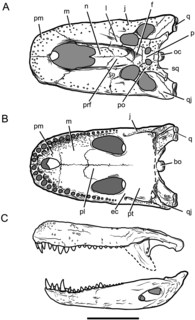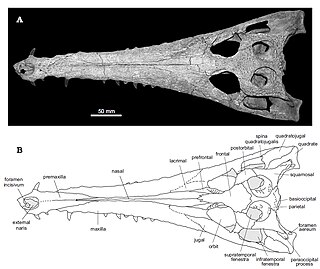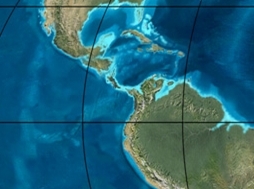
Gavialidae is a family of large semiaquatic crocodilians with elongated, narrow snouts. Gavialidae consists of two living species, the gharial and the false gharial, both occurring in Asia. Many extinct members are known from a broader range, including the recently extinct Hanyusuchus. Gavialids are generally regarded as lacking the jaw strength to capture the large mammalian prey favoured by crocodiles and alligators of similar size so their thin snout is best used to catch fish, however the false gharial has been found to have a generalist diet with mature adults preying upon larger vertebrates.

Melanosuchus is a genus of alligatorid caiman. The black caiman of South America is the sole extant (living) species, and is the largest living member of the subfamily caimaninae, and the entire alligator family.

Purussaurus is an extinct genus of giant caiman that lived in South America during the Miocene epoch, from the Colhuehuapian to the Montehermosan in the SALMA classification. It is known from skull material found in the Brazilian and Peruvian Amazon, Colombian Villavieja Formation, Panamanian Culebra Formation and the Urumaco and Socorro Formations of northern Venezuela.
Charactosuchus is an extinct genus of crocodilian. It was assigned to the family Crocodylidae in 1988. Specimens have been found in Colombia, Brazil, Jamaica, and possibly Florida and South Carolina. It was gharial-like in appearance with its long narrow snout but bore no relation to them, being more closely related to modern crocodiles than to gharials.
Eogavialis is an extinct genus of eusuchian crocodylomorph, usually regarded as a gavialoid crocodylian. It superficially resembles Tomistoma schlegelii, the extant false gharial, and consequently material from the genus was originally referred to Tomistoma. Indeed, it was not until 1982 that the name Eogavialis was constructed after it was realised that the specimens were from a more basal form.

Eosuchus is an extinct genus of eusuchian crocodylomorph, traditionally regarded as a gavialoid crocodilian. It might have been among the most basal of all gavialoids, lying crownward of all other known members of the superfamily, including earlier putative members such as Thoracosaurus and Eothoracosaurus. Fossils have been found from France as well as eastern North America in Maryland, Virginia, and New Jersey. The strata from which specimens have been found date back to the late Paleocene and early Eocene epochs.

Gryposuchus is an extinct genus of gavialid crocodilian. Fossils have been found from Argentina, Colombia, Venezuela, Brazil and the Peruvian Amazon. The genus existed during the Miocene epoch. One recently described species, G. croizati, grew to an estimated length of 10 metres (33 ft). Gryposuchus is the type genus of the subfamily Gryposuchinae, although a 2018 study indicates that Gryposuchinae and Gryposuchus might be paraphyletic and rather an evolutionary grade towards the gharial.
Ikanogavialis is an extinct genus of gavialid crocodilian. Fossils have been found in the Urumaco Formation in Urumaco, Venezuela and the Solimões Formation of Brazil. The strata from which remains are found are late Miocene in age, rather than Pliocene as was once thought. A possible member of this genus survived into the Late Holocene on Muyua or Woodlark Island in Papua New Guinea.

The Castillo Formation is an Early Miocene geologic formation in the Falcón Basin of Venezuela. The formation unconformably overlies the Matatere, Misoa, El Paují and Jarillal Formations. The Castillo Formation is overlain by Quaternary alluvium and in places by the Capadare Formation. The formation, deposited in a calm near-shore lagoonal brackish environment, with possibly fluvial influence, has provided a rich assemblage of fossil crocodylians, turtles, giant sloths and various types of fish.

Piscogavialis is an extinct monospecific genus of gryposuchine gavialid crocodylian. The only species yet known is P. jugaliperforatus. Fossils of Piscogavialis have been found from the Mio-Pliocene Pisco Formation of the Sacaco Basin in southern Peru in 1998, where it coexisted with the much smaller gavialid Sacacosuchus.
Siquisiquesuchus is an extinct genus of gavialid crocodilian. It is known from cranial remains and a few postcranial bones found in Miocene-age rocks of the Castillo Formation in northwestern Venezuela.

Penghusuchus is an extinct genus of gavialid crocodylian. It is known from a skeleton found in Upper Miocene rocks of Penghu Island, off Taiwan. It may be related to two other fossil Asian gavialids: Maomingosuchus petrolica of southeastern China and Toyotamaphimeia machikanensis of Japan. The taxon was described in 2009 by Shan and colleagues; the type species is P. pani.
Gryposuchinae is an extinct subfamily of gavialid crocodylians. Gryposuchines lived mainly in the Miocene of South America. However, "Ikanogavialis" papuensis may have survived more recently, into the Late Pleistocene/Holocene. Most were long-snouted coastal forms. The group was named in 2007 and includes genera such as Gryposuchus and Aktiogavialis, although a 2018 study indicates that the group might be paraphyletic and rather an evolutionary grade towards the gharial.

Gavialoidea is one of three superfamilies of crocodylians, the other two being Alligatoroidea and Crocodyloidea. Although many extinct species are known, only the gharial Gavialis gangeticus and the false gharial Tomistoma schlegelii are alive today, with Hanyusuchus having become extinct in the last few centuries.
Globidentosuchus is an extinct genus of basal caimanine crocodylian known from the late Middle to Late Miocene of the Middle and the Upper Members of the Urumaco Formation at Urumaco, Venezuela. Its skull was very short and robust, with large units of spherical teeth used to break the shells of molluscs as part of its durophagus diet. It is thought to be one of the most basal Caimanines, even sharing some traits with alligatorids.

Caiman wannlangstoni is an extinct species of caiman that lived in what is now the Amazon Basin and surrounding areas during the Middle and Late Miocene. Fossils of C. wannlangstoni have been found in the Pebas Formation near Iquitos in Peru and include partial skulls and isolated skull bones. Other fossils were uncovered from the Urumaco Formation in Venezuela and the Laventan Honda Group of Colombia. The species was first described in 2015. Features that in combination distinguish C. wannlangstoni from other caimans include a deep snout, a wavy upper jaw margin, a large and upward-directed narial opening, and blunt teeth at the back of the jaws. Based on the sizes of the skulls, its estimated body length is about 211 to 227 centimetres.
The Urumaco Formation is a formation in Venezuela that includes deposits from the Late Miocene. It is the site of several "giant forms": the turtles, crocodiles, sloths and rodents of Urumaco are among the largest of their groups.
Caiman brevirostris is an extinct species of caiman described in 1987 on the basis of an incomplete rostrum and partial right mandible that was collected from the Miocene age Solimões Formation of Acre, Brazil.
Acresuchus is an extinct monospecific genus of large caiman from the Late Miocene of western Brazil and of Venezuela. The genus contains a single species, Acresuchus pachytemporalis. Acresuchus is a close relative of the giant caiman Purussaurus.
Dadagavialis is an extinct monospecific genus of gavialid crocodylian that lived during the Early Miocene in what is now Panama. It was described in 2018, and was proposed to be a member of Gryposuchinae. However, other studies have shown Gryposuchinae to be paraphyletic and rather an evolutionary grade towards the living gharial, and thus Dadagavialis might just be classified as a member of Gavialidae.












